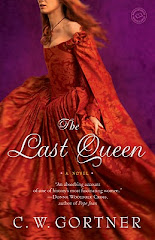I'm very pleased to introduce Tony Hays, a fellow author and friend whose Arthurian mystery series, starting with The Killing Way, has been welcomed with great enthusiasm by readers. Set in a medieval Britian replete with intrigue, mysticism and lethal betrayal, this is not your average re-telling of the Arthurian legend; it's more like CSI: Medieval: gritty, powerful, and with t he true ring of historical perspective. Tony's second entry in the series, The Divine Sacrifice , is due out March 30, 2010 and he is under contract for three more books. A native of Madison, Tennessee, Tony is an extensive traveler, who has visited 30 countries and lived in six. You can learn more about Tony and his work at: tonyhays.com
he true ring of historical perspective. Tony's second entry in the series, The Divine Sacrifice , is due out March 30, 2010 and he is under contract for three more books. A native of Madison, Tennessee, Tony is an extensive traveler, who has visited 30 countries and lived in six. You can learn more about Tony and his work at: tonyhays.com
Please join me in welcoming Tony Hays to Historical Boys!
The one question that I get at virtually every place I visit is: Was King Arthur a real person. The short answer is nobody knows. The esteemed historians and archaeologists who say “no” can’t prove their position. And those of us who believe that Art hur did exist can’t prove our position either. Not definitively.
hur did exist can’t prove our position either. Not definitively.
 he true ring of historical perspective. Tony's second entry in the series, The Divine Sacrifice , is due out March 30, 2010 and he is under contract for three more books. A native of Madison, Tennessee, Tony is an extensive traveler, who has visited 30 countries and lived in six. You can learn more about Tony and his work at: tonyhays.com
he true ring of historical perspective. Tony's second entry in the series, The Divine Sacrifice , is due out March 30, 2010 and he is under contract for three more books. A native of Madison, Tennessee, Tony is an extensive traveler, who has visited 30 countries and lived in six. You can learn more about Tony and his work at: tonyhays.comPlease join me in welcoming Tony Hays to Historical Boys!
The one question that I get at virtually every place I visit is: Was King Arthur a real person. The short answer is nobody knows. The esteemed historians and archaeologists who say “no” can’t prove their position. And those of us who believe that Art
 hur did exist can’t prove our position either. Not definitively.
hur did exist can’t prove our position either. Not definitively.Certainly the Arthur of “Sword in the Stone” and T.H. White’s “The Once and Future King” isn’t real. They owe their lives to Geoffrey of Monmouth, who concocted a life for, what was in Geoffrey’s time, a shadowy figure named Arthur, who was definitely a soldier and might have been a king, but who, nonetheless, had captured his countrymen’s hearts.
We can say, with nearly complete assurance, that characters such as Lancelot and Galahad are the creation of such romancers as Chretien de Troyes. They are fictional. But scattered out among all the intriguing bits and pieces of history before Geoffrey of Monmouth, there is enough to at least tentatively label Guinevere, Bedevere, Kay, Mordred, Gawain, and others as based on historical figures. Merlin most likely has historical roots as well, but he came along about a generation after Arthur.
I learned recently that some researchers believe that Arthur’s sister, Morgan le Fay, was actually based on a person named Morgan ap Tud, touted in The Mabinogion (a collection of tales from old Wales) as Arthur’s court physician. Galahad is believed by some to have been inspired by a soldier/saint named Illtud, said to be a cousin of Arthur’s.
Recently, in a talk sponsored by Clues Unlimited and the Department of History at the University of Arizona, I was asked this very question, and I answered this way: “I believe that there was someone, a single individual whose exploits prompted the Arthurian myth. “ I stand on that statement.
Of all the many candidates for an historical Arthur, I believe that renowned Arthurian scholar Geoffrey Ashe has hit upon the most promising. In the last years of the 5th century, a British leader named Riothamus came to power. The very name “Riothamus” could be interpreted as “most high king.” A letter to him by poet Sidonius Appollinaris survives and hints that he was known for his commitment to justice and doing the right thing. This same Riothamus took an army to Gaul (as Arthur is said to have done), was betrayed by one of his own men, and was last seen retreating toward Avallone in France. The coincidences just pile up.
Does all of this (or should all of this) detract from the mystery, the legend, the magic of the literary Arthur that has emerged? Not for me. Arthur has become such a symbol, a Christian king who believed in right before might, a tragically flawed figure betrayed by those surrounding him, but also a charismatic leader who, even yet, could return to save us from ourselves. That such a man could have a basis in history, could have actually lived, brings me comfort, not distress. Hope, not despair.
Thank you, Tony. We look forward to the next book and wish you much success!













1 comment:
I am newly interested in Arthurian literature, so thanks so much for posting about this.
Post a Comment